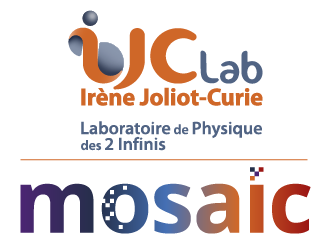The particularity of the transmission electron microscope (TEM) of the MOSAIC platform is its coupling to the ARAMIS and IRMA ion accelerators in the JANNuS-Orsay experimental hall, allowing the simultaneous ion implantation and irradiation of materials in situ in the microscope. Learn more about in situ TEM experiments
The microscope remains available for ex situ observations and analysis (without connection to the ion beams), according to the schedule possibilities.
TEM characteristics
FEI (Thermofisher) microscope, Tecnai G² 20 Twin model
- High tension : 200 kV
- Electron gun : LaB6
- Spatial resolution : 0.27 nm
- Line resolution : 0.13 nm
- Spherical aberration coefficient : 2.0 mm
- Vacuum in the specimen chamber : 1×10-7 Torr
- Tilt angles : α tilt ± 70° ; tilt β depends on the sample holder
- Microprobe and nanoprobe modes, STEM
- Minimum spot size at 200 kV : 10 nm
- Magnification ranges : from 70 to 620 000
- Apertures :
- Condenser : 30, 50, 100, 200 µm
- Objective : 10, 20, 40, 100 µm
- Area selection : 10, 40, 200, 800 µm
Specimen holders (for 3 mm diameter grids) :
- Room temperature specimen holders :
|
Type |
β tilt |
Remarks |
|
FEI single tilt |
|
|
|
FEI double tilt |
± 30° |
EDX analysis |
|
Gatan double tilt |
± 30° |
EDX analysis and Faraday cup |
|
PhilipsTilt Rotation |
± 360° |
|
- Heating specimen holders :
|
Type |
β tilt |
Max. temperature |
|
|
Gatan heating double tilt |
± 30° |
700°C |
Inconel |
|
Gatan heating single tilt |
– |
1300°C |
Tantalum |
|
Gatan heating double tilt, specially designed for in situ ion irradiation |
± 30° |
800°C |
Inconel |
- Cooled specimen holder :
|
Type |
β tilt |
Max. temperature |
Remarks |
|
Gatan cooled double tilt |
± 25° |
LN2 |
EDX analysis |
Recording capabilities
OneView GATAN camera
Available analysis
- EDX
- GIF: EELS, EFTEM
- STEM, HAADF
Preparation of thin foils
Various specific equipment related to the preparation and cleaning of thin foils for transmission electron microscopy are available in the laboratory, and in particular:
- cutting (wire saw, disc saw)
- mechanical preparations (slow or normal speed polishers, tripod, dimpler, ultramicrotome)
- ion polishing (PIPS)
- electrolytic polishing (Tenupol 5)
- chemical polishing
- carbon and gold deposition by ion sputtering
- cleaning by plasma cleaner (Ar, O, H)
- observation using an optical microscope equipped with a camera
Please contact Florian Pallier for any questions related to this sample preparation equipment.
References
- Investigating radiation damage in nuclear energy materials using JANNuS multiple ion beams, A. Gentils, C. Cabet, Nuclear Instruments and Methods B 447 (2019) 107-112 doi
- In situ Transmission Electron Microscopy Ion Irradiation Studies at Orsay, M.-O. Ruault, F. Fortuna, H. Bernas, J. Chaumont, O. Kaïtasov, V.A. Borodin, Journal of Materials Research 20 (2005) 1758-1768 doi
Contact
TEM technical manager: Dr Cédric Baumier
For in situ TEM experiments with ion accelerators, you must submit a request during the annual call for experiment proposals (generally in September-October) on the EMIR&A , network website, after discussing it with local contacts (Cédric Baumier, Aurélie Gentils, Stéphanie Jublot-Leclerc).
For any request for accessing the microscope, please contact the microscopists who examine new projects and new investments around the microscope and sample preparation: mosaic@ijclab.in2p3.fr







